
The Oswego Valley, 1756
20th March 2022, 2 Comments
The French & Indian War, Muskets & Tomahawks, 28mm
At long last. I haven’t been to a “League of Gentlemen Wargamers” weekend since Covid first reared its head. This weekend though, ended that drought. As usual we gathered in Kirriemuir near Dundee – a long ferry trip and a short drive away for me – for a weekend of gaming set in the French & Indian Wars. Best of all, by the time I arrived on Saturday morning the scenic Oswego valley was already all laid out. All I had to do was to unload my figures and get to it.  There were only eight of us this weekend – about two-thirds of the usual number – but that was more than enough. The weekend was ably organised by Charlie Grant, who’s divided us into British, French and Native American factions. So, after choosing our small 250 point starter force, we began with a series of small one-on-one scenarios, designed to re-acquaint ourselves with the rules.
There were only eight of us this weekend – about two-thirds of the usual number – but that was more than enough. The weekend was ably organised by Charlie Grant, who’s divided us into British, French and Native American factions. So, after choosing our small 250 point starter force, we began with a series of small one-on-one scenarios, designed to re-acquaint ourselves with the rules. 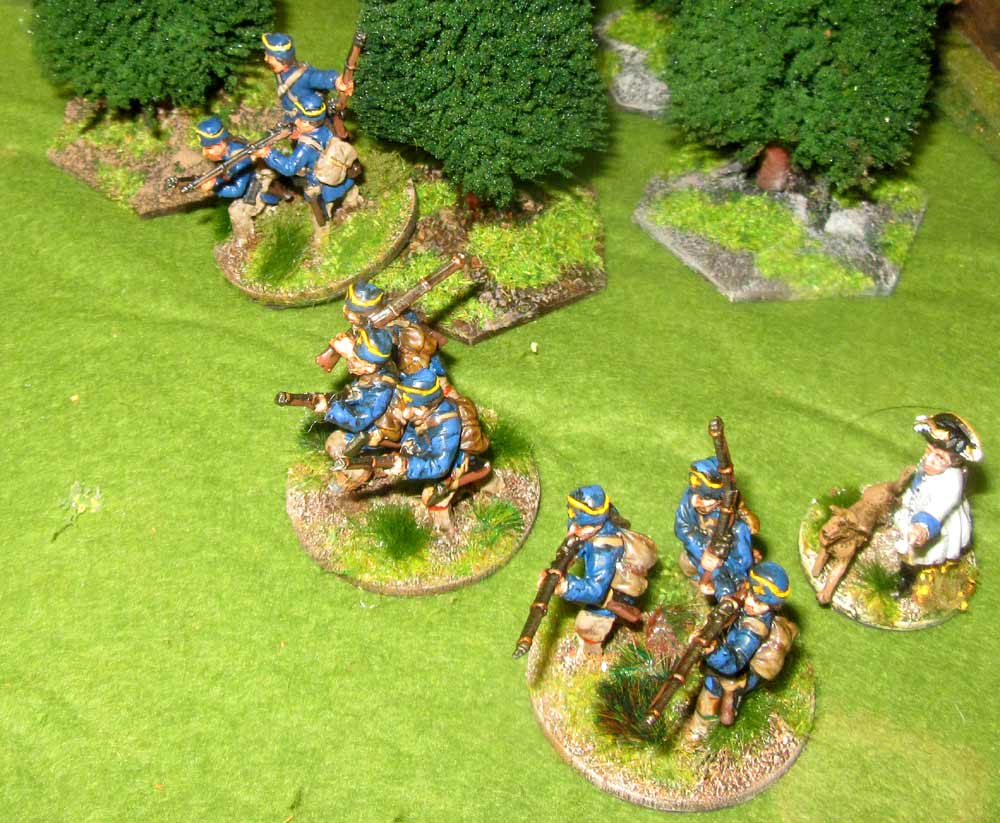 That was certainly handy. I haven’t played a Muskets & Tomahawks game for about five years, as for his period I’ve switched to the simpler and faster Rebels & Patriots. Each lasted for an hour or two, with the scenarios designed to be both fun and challenging. My first against Steve Rimmer and his British-allied Indians was the most straightforward of the four that day – a lot of hiding from the rifle-armed indians, as my Canadian militia and Compagnies franches de la Marine (pictured above) didn’t have the same level of firepower. Still, somehow the game ended up as a draw, after a less than successful Indian assault on my skulking troops.
That was certainly handy. I haven’t played a Muskets & Tomahawks game for about five years, as for his period I’ve switched to the simpler and faster Rebels & Patriots. Each lasted for an hour or two, with the scenarios designed to be both fun and challenging. My first against Steve Rimmer and his British-allied Indians was the most straightforward of the four that day – a lot of hiding from the rifle-armed indians, as my Canadian militia and Compagnies franches de la Marine (pictured above) didn’t have the same level of firepower. Still, somehow the game ended up as a draw, after a less than successful Indian assault on my skulking troops. 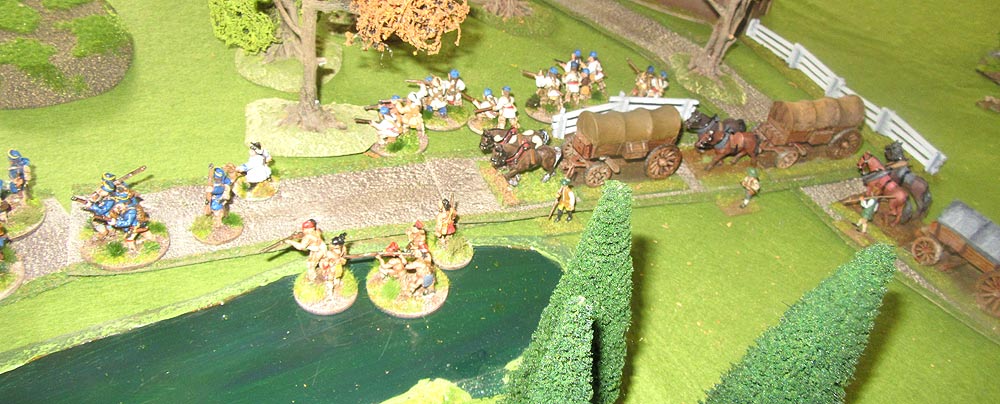 The next was much more fun – I was guarding the passage of supplies to a French-held blockhouse, while Charles Grant was doing his best to stop me. Its always a pleasure gaming with Charles – a true wargaming gentleman, and as a retired brigadier I expected he’d show me a thing or two about proper tactics. In fact, Charles’ textbook game plan was pretty simple – a series of blocking lines, with an advanced line, a main one, and a reserve one, closest to the blockhouse. I saw off the first one when his British-allied Indians ran away after Charles rolled ones, but his main line of light infantry and highlanders (of course) were a far tougher nut to crack.
The next was much more fun – I was guarding the passage of supplies to a French-held blockhouse, while Charles Grant was doing his best to stop me. Its always a pleasure gaming with Charles – a true wargaming gentleman, and as a retired brigadier I expected he’d show me a thing or two about proper tactics. In fact, Charles’ textbook game plan was pretty simple – a series of blocking lines, with an advanced line, a main one, and a reserve one, closest to the blockhouse. I saw off the first one when his British-allied Indians ran away after Charles rolled ones, but his main line of light infantry and highlanders (of course) were a far tougher nut to crack. 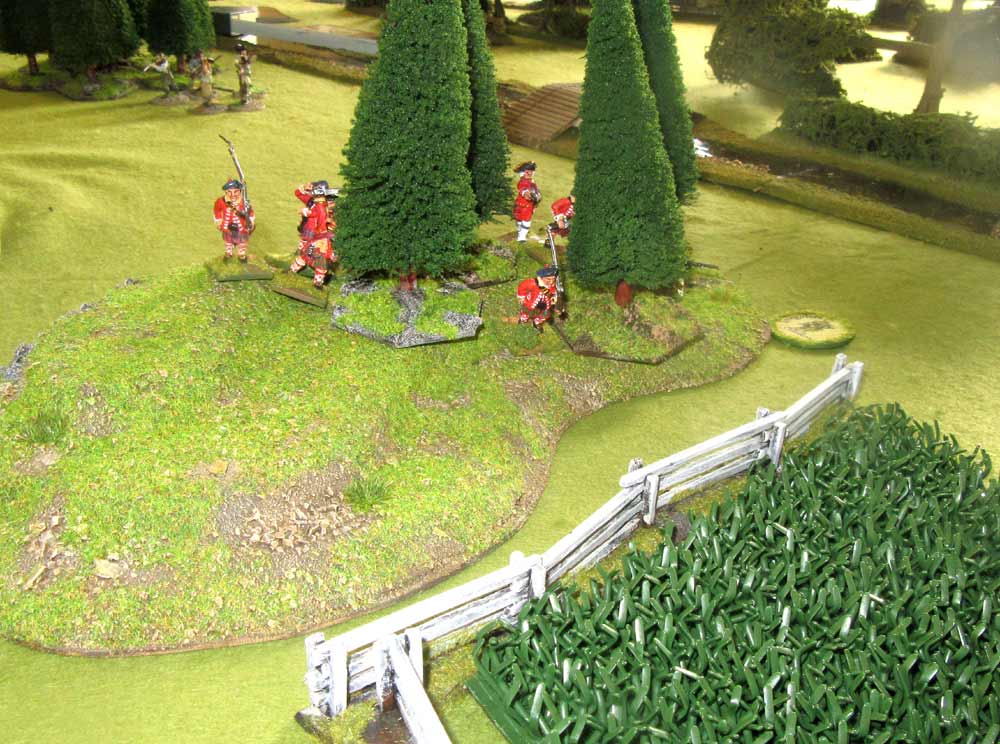 In the end though, all the elite troops in the world can still be shot, and that’s exactly what my Indians and Canadian militiamen did. So, when both the lights and the highlanders were forced to retire, I occupied the ridge they were holding, and was able to turn the tide. it was a close-fought game though, and actually Charles stalled my supply column long enough to make the game a draw.
In the end though, all the elite troops in the world can still be shot, and that’s exactly what my Indians and Canadian militiamen did. So, when both the lights and the highlanders were forced to retire, I occupied the ridge they were holding, and was able to turn the tide. it was a close-fought game though, and actually Charles stalled my supply column long enough to make the game a draw.  Next up was one against Alan Lipowski, an army buddy of Charlie and a lovely guy. His job was to drive me out of another blockhouse, held by a unit of 12 Compagnie franches de la Marine. In this one, Alan used all his soldierly skills to drive me out, opting for firepower to do the job rather than an assault. I had reinforcements coming, but their arrival was variable, and in the end they arrived one turn too late to save the day. My garrison was overrun, and the fort gates were slammed in the faces of my relief force!
Next up was one against Alan Lipowski, an army buddy of Charlie and a lovely guy. His job was to drive me out of another blockhouse, held by a unit of 12 Compagnie franches de la Marine. In this one, Alan used all his soldierly skills to drive me out, opting for firepower to do the job rather than an assault. I had reinforcements coming, but their arrival was variable, and in the end they arrived one turn too late to save the day. My garrison was overrun, and the fort gates were slammed in the faces of my relief force!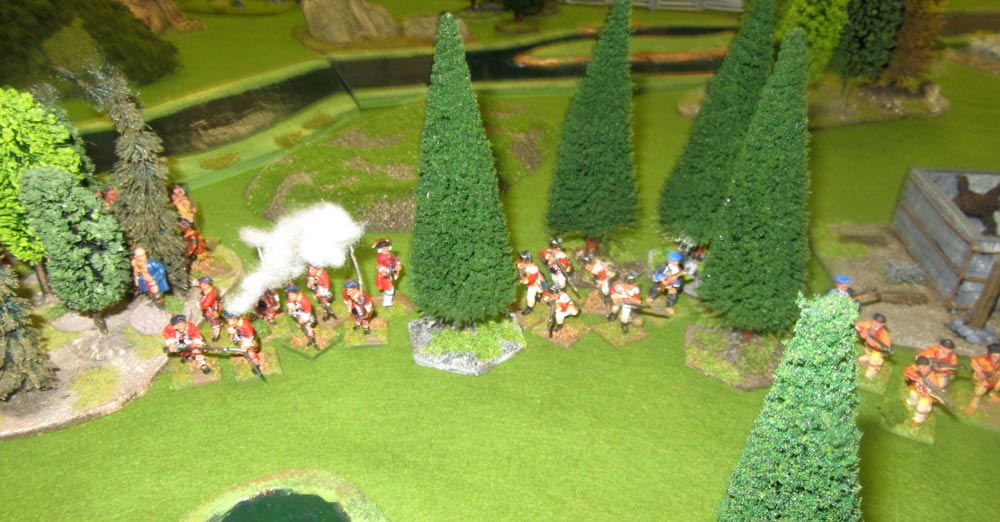 So, with two draws and a loss, it was on to the last game of the day, against Kieron Potts. Another army type, Kieron is an extremely gentlemanly wargame opponent, with an excellent sense of humour. Like Charles though, his weakness is a fondness for highlanders – something I planned to exploit. We had a truly excellent game,the high point for me being the wiping out of his highland grenadiers by half their number of Mohawks. He had his revenge though, when we were both down to two men and a dog. It was then he launched a last-ditch charge against my Canadian militia, and won the day – literally with three men, and on the turn of a card!
So, with two draws and a loss, it was on to the last game of the day, against Kieron Potts. Another army type, Kieron is an extremely gentlemanly wargame opponent, with an excellent sense of humour. Like Charles though, his weakness is a fondness for highlanders – something I planned to exploit. We had a truly excellent game,the high point for me being the wiping out of his highland grenadiers by half their number of Mohawks. He had his revenge though, when we were both down to two men and a dog. It was then he launched a last-ditch charge against my Canadian militia, and won the day – literally with three men, and on the turn of a card!  On Sunday morning we moved on to a large game involving everybody. Both sides were fairly intermixed, and the Oswego River pretty much cut the campaigning area in two. Still, we gave it our best shot. My contingent – 400 points of Compagnie franches de la Marine, Canadian militia and Mohawks spent Sunday morning burning bridges, attempting a doomed river crossing by boat, then reinfocing failure by trying it again across the one remaining pontoon bridge!
On Sunday morning we moved on to a large game involving everybody. Both sides were fairly intermixed, and the Oswego River pretty much cut the campaigning area in two. Still, we gave it our best shot. My contingent – 400 points of Compagnie franches de la Marine, Canadian militia and Mohawks spent Sunday morning burning bridges, attempting a doomed river crossing by boat, then reinfocing failure by trying it again across the one remaining pontoon bridge! On the far side of the river my pal Chris was caught between Alan’s British regulars and Steve’s Iroquois with their hunting rifles. It was Alan who thwarted my river assaults, so I settled for some long-range sniping of Kieron’s highlanders. Further up the valley Dale Smith and Kevin Calder battled Kieron and Charles’ British, without anyone really making much headway. It looked good though!
On the far side of the river my pal Chris was caught between Alan’s British regulars and Steve’s Iroquois with their hunting rifles. It was Alan who thwarted my river assaults, so I settled for some long-range sniping of Kieron’s highlanders. Further up the valley Dale Smith and Kevin Calder battled Kieron and Charles’ British, without anyone really making much headway. It looked good though!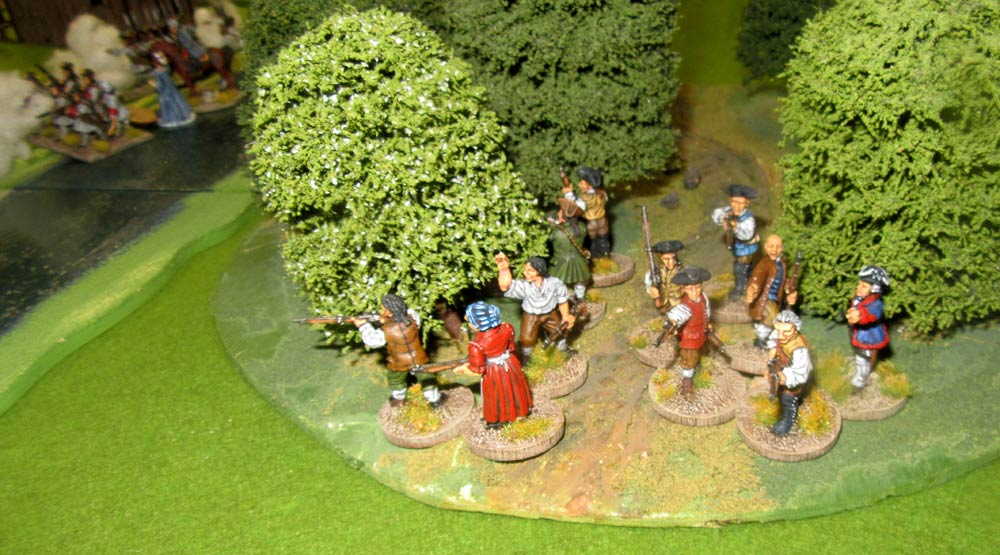 I did what I could to help Kevin, the fire of my own Indians helping protect the flank held by his doughty French armed settlers and militiamen. I couldn’t intervene in the main fight though, thanks to the river. I did more to help Chris though, as at least my my doomed assaults across the pontoon bridge helped whittle down Alan’s best units, allowing Chris to take on the rest with his French Marines.
I did what I could to help Kevin, the fire of my own Indians helping protect the flank held by his doughty French armed settlers and militiamen. I couldn’t intervene in the main fight though, thanks to the river. I did more to help Chris though, as at least my my doomed assaults across the pontoon bridge helped whittle down Alan’s best units, allowing Chris to take on the rest with his French Marines.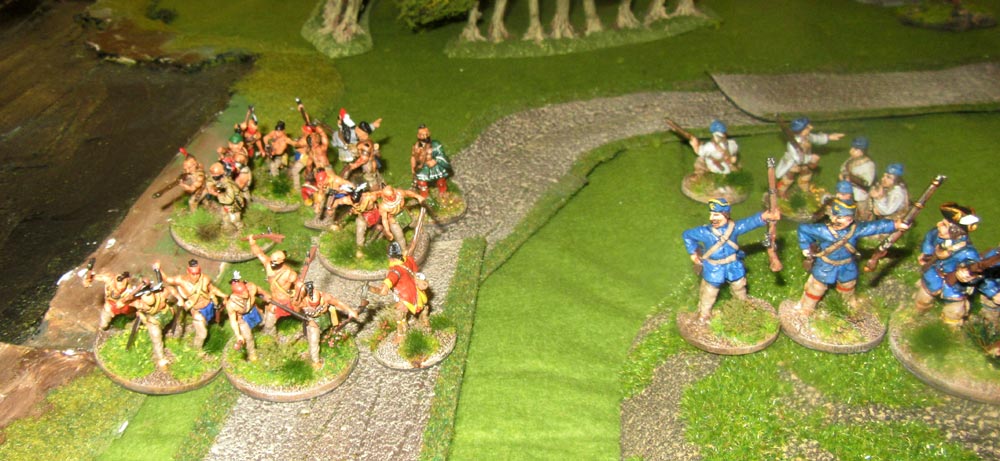 In the end though, I had to go, as I had a ferry to catch. It was pretty much time to finish anyway though, and Charlie wrapped up the game. In the end, the weekend’s play was deemed a minor British victory. that though, was less important that actually being able to spend a weekend hanging out with friends, rolling dice, shuffling lead and generally having a great time. Roll on the next LoGW game!
In the end though, I had to go, as I had a ferry to catch. It was pretty much time to finish anyway though, and Charlie wrapped up the game. In the end, the weekend’s play was deemed a minor British victory. that though, was less important that actually being able to spend a weekend hanging out with friends, rolling dice, shuffling lead and generally having a great time. Roll on the next LoGW game! 


This weekenders with a lot of like-minded gents always read like great fun. Glad to see you were able to do one again. Love those Compagnies franche de la Marine troops too. An enjoyable read, thanks!
They are great fun, Joe. I also didn’t mention the social side – the dinner, and the evening chatting and drinking in the pub. I can’t say the rules are my favourites, but it was great fun nevertheless. As for my Marines, they’re one of my favourites – very distinctive uniforms! Like the rest of my F&IW kit, I’ve debased them in groups, for easier movement. I’m now doing the,same thing with my Colonial stuff.